Up Next
Piper Bangs Just Graduated From College. Now Her Fantastical Fruit Paintings Are Captivating the Art World
We spoke with the 21-year-old painter about her debut show at the just-opened Megan Mulrooney gallery in Los Angeles.
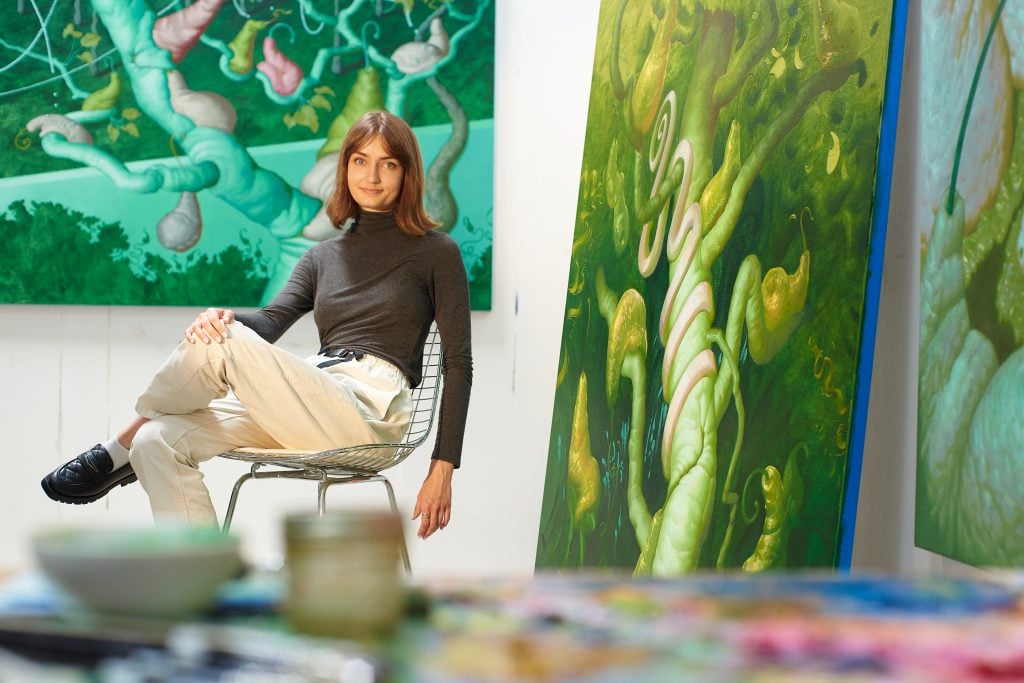
We spoke with the 21-year-old painter about her debut show at the just-opened Megan Mulrooney gallery in Los Angeles.

Annikka Olsen

“While I have really specific ideas about what’s going on in the paintings, I also love when people come to the paintings and have their own ideas about what’s going on,” said artist Piper Bangs on a video call earlier this month. “So it’s important to me that the paintings are also open-ended enough, that people can come to them and imagine what’s going on in different ways.”
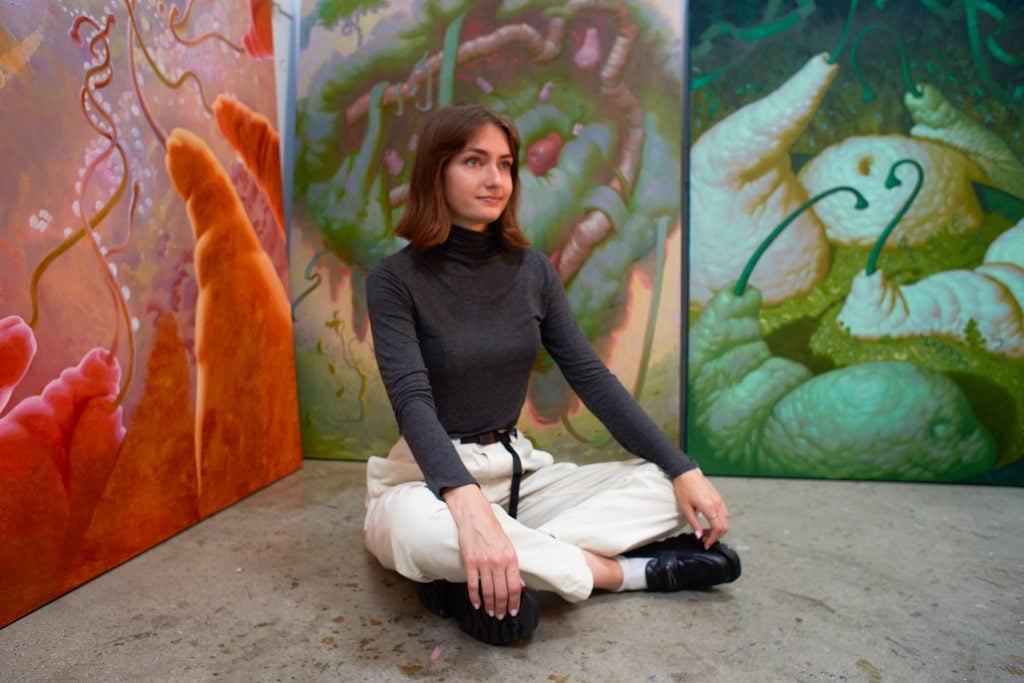
Piper Bangs. Photo: Reid Calvert. Courtesy of the artist and Megan Mulrooney, Los Angeles.
Originally from San Antonio, Texas, and currently based in Los Angeles, Bangs recently (very recently, just this past May) graduated from the Laguna College of Art and Design where she studied painting and drawing. Her first solo show was in 2022 at the Watermill Center in New York, “Flora,” which was followed early last year by another solo, “Flora II,” in a collaboration between the Watermill Center and Estia’s Little Kitchen in Sag Harbor. This month, Bangs is slated to make her Los Angeles debut with a solo show at the newly established Megan Mulrooney gallery with “Piper Bangs: Fruiting Body,” on view September 14–October 26, 2024.
Mulrooney has notably taken over three of the spaces formerly occupied by Nino Mier Gallery following the latter’s divestment of all locations in Los Angeles. Bangs was originally slated for a solo show with Mier this past June. With the changing gallery landscape, her show was picked up instead by Mulrooney (who formerly worked with Mier), and her exhibition will be one of the gallery’s inaugural exhibitions. It’s an exciting moment for the gallery and artist as it marks important firsts for each.
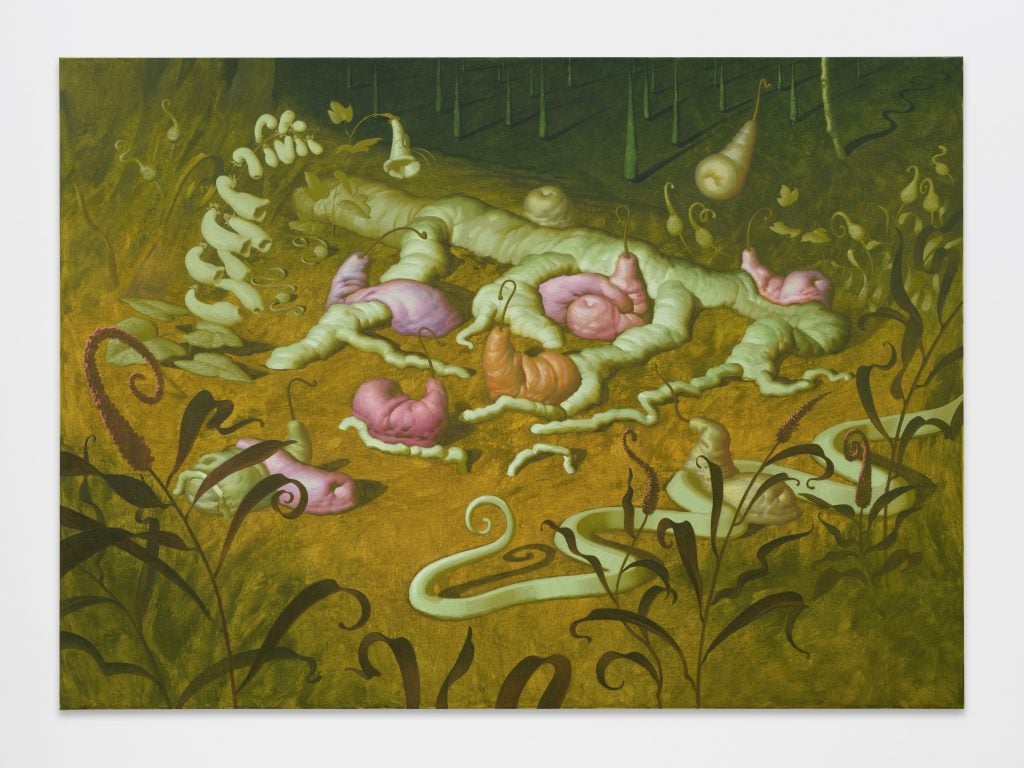
Piper Bangs, Fallen Fruit (2024). Photo: Photo by Paul Salveson. Courtesy of the artist and Megan Mulrooney, Los Angeles.
Fleshy and organic with a pervasive sense of fantasy, the paintings Bangs create are brimming with a type of life that is simultaneously alien and familiar. Across the works included in “Fruiting Body,” are “fruits” that are rendered with elements of figurations as well as objecthood. They are at times, frankly, a bit gross to look at, but at others rather cute. The show’s title is drawn from the spore-producing reproductive organ of fungi, such as toadstools, and offers insight into Bangs’s choice of subject.
“When I was coming up with this ‘fruit,’ maybe a year or two ago, I was looking at a lot of Renoir and reading classic Linda Nochlin. Instead of making figurative paintings in the European tradition like I’d been taught, I didn’t want there to be sexualized nude women’s bodies,” explained Bangs. “But I still wanted to think about themes that have to do with my own experiences, so I started using ‘fruit characters’ that were still kind of figurative, but not so much an actual figure … I wanted them to have internal lives, so now these fruits I think of as acting out narratives from the perspective of a young woman and themes that I’m thinking about, like the search for community, sensuality, and the sharing of knowledge.”
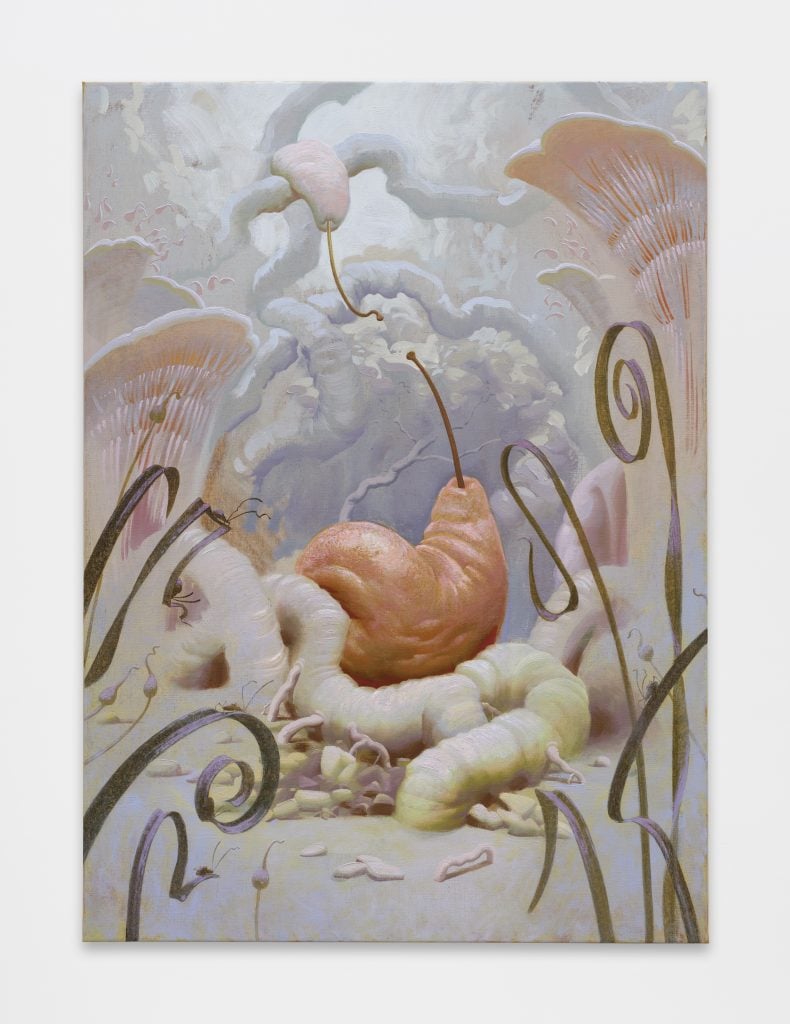
Piper Bangs, Forest Floor (2024). Photo: Photo by Paul Salveson. Courtesy of the artist and Megan Mulrooney, Los Angeles.
Pears were the initial starting point for Bangs as their natural shape evoked bodily figuration. But eventually, these were largely subsumed by imaginative additions and rendering techniques, “I wanted them to feel really fleshy and anthropomorphic, they have what I think of as stomach rolls and cellulite, but they’ve definitely departed from anything that’s real.” Stories unfold in vignettes in these works, presenting moments of exploration, learning, and even coming of age. There exists what Bangs describes as a “mentor tree” from which the fruits originate in their journey and offer a window into the works’ narrative symbolism.
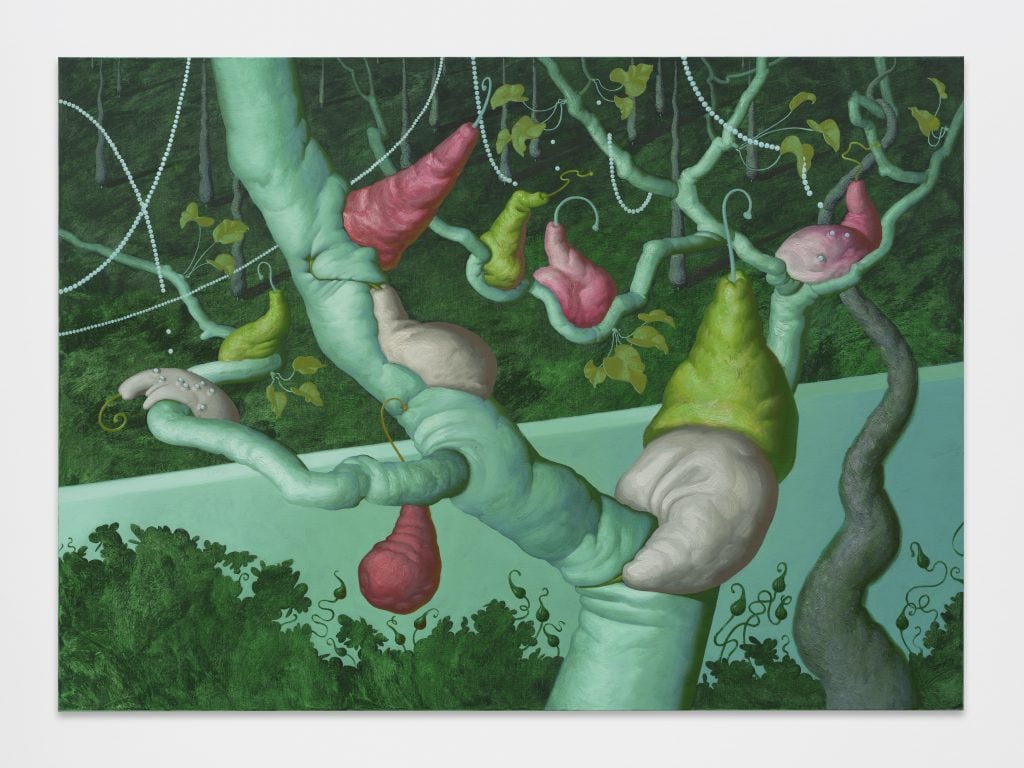
Piper Bangs, Pearls and Onlookers (2024). Photo: Photo by Paul Salveson. Courtesy of the artist and Megan Mulrooney, Los Angeles.
In Pearls and Onlookers (2024), the fleshy fruits appear almost slug-like on a teal tree. A string of pearls hangs between the tree’s branches alluding to the idiom “pearls of wisdom.” One of the green fruits toward the center of the composition appears to spurn the pearls, as they fly into open air. A particularly droopy gray fruit at the left has been embedded with more than a half dozen pearls even as two more drop down towards it. The pearls appear again in Transferring (2024), in which several smaller fruits gather around a pearl-laden larger fruit and appear to share the pearls across their stems.
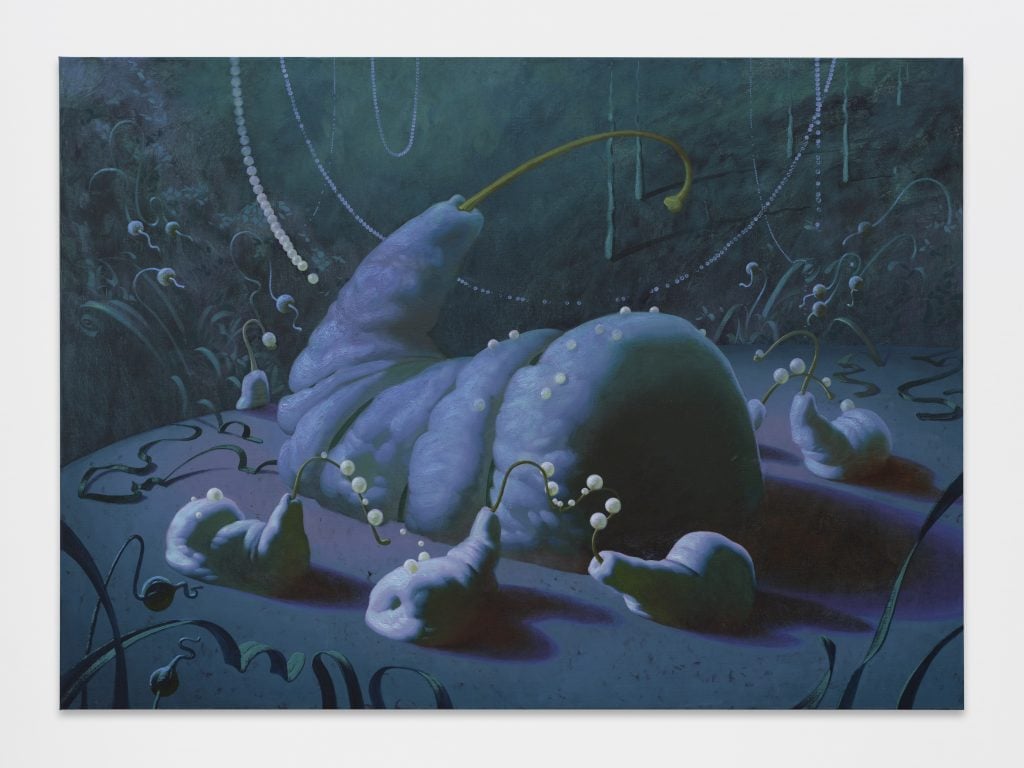
Piper Bangs, Transferring (2024). Photo: Photo by Paul Salveson. Courtesy of the artist and Megan Mulrooney, Los Angeles.
Recalling Bangs’s classical inspirations, Bathers (2024) evokes both en plein air scenes à la Édouard Manet as well as traditional still lifes—with 17th-century Dutch Golden Age and Spanish paintings by artists such as Francisco de Zurbarán also as notable influences. Despite the aura of fantasy and make-believe subject matter, much of this classical evocation can be attributed to Bangs’s use of traditional techniques.
Trained in the tradition of French academic painting, Bangs relishes in the formal and technical development of each canvas, which includes beginning with a thumbnail that is developed and scaled before using traditional grisaille, or black-and-white tonal, underpainting to block out the final composition on canvas. With the major elements placed, she has the latitude to play with the smaller, more detailed aspects, allowing for a degree of compositional experimentation. Taking inspiration from the techniques of Old Master and Rococo paintings, their brush strokes, execution of line, and lush color palettes result in works that ultimately seem to be outside of time—truly unto a world of their own.
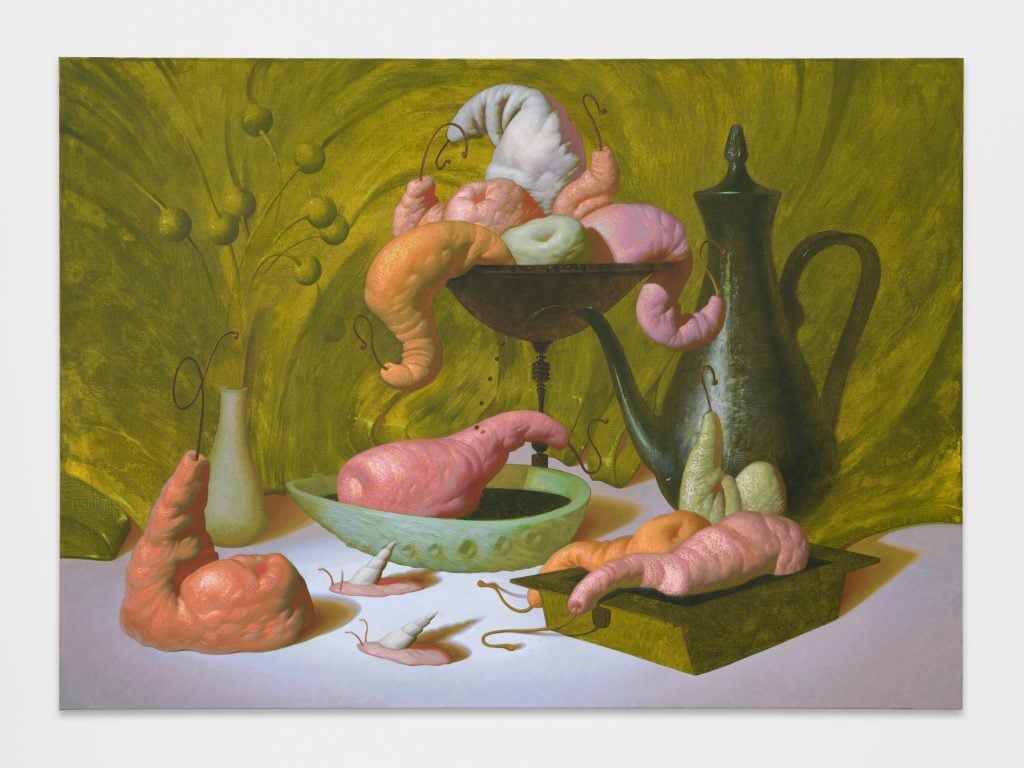
Piper Bangs, Bathers (2024). Photo: Photo by Paul Salveson. Courtesy of the artist and Megan Mulrooney, Los Angeles.
While Bangs aims to leave her canvases open-ended enough for viewers to bring their own interpretations and readings to the compositions, it also leaves ample room for her to continue exploring the creative worlds and avenues presented within “Fruiting Body.” On what might be coming next in her practice, Bangs said, “The uncanny is really appealing to me in terms of the mood of the paintings. This show’s paintings are really fantastical, I want them to get a bit closer to reality, where when you look at them you can almost believe that they’re these things in the world.”